-

人教版高中英语必修3Healthy Eating说课稿4篇
Language learning needs a context, which can help the learners to understand the language and then can product comprehensible output, so computer has the advantages to make the materials attractive.Part 3 Learning MethodsTask-based, self-dependent and cooperative learningPart 4 Teaching ProcedureStep One Lead-in“Interest is the best teacher.” Therefore, at the very beginning of the class, I should spark the students’ mind to focus on the centre topic “the band”. I’ll show some pictures of food to attract their attention and then bring some questions.Question:What kind of food they like?What should go into a good meal?The answers must relate to the diet. After this, the students will be eager to know something about a balance diet and this is the very time to naturally lead the class into Step 2Step 2 Reading for information: skimming and scanning In this step, I use Task-based Language Teaching method, which can give students a clear and specific purpose while skimming and scanning the context.Task 1 General ideaThe students will be asked to just glance at the title and the pictures of the passage, and then guess what they will read in the text. And they’ll be divided into groups of four to have a discussion.The purpose is to inspire the students to read actively, not passively. In addition, the task is to develop the students’ reading skill by making prediction and to encourage the students to express their thoughts in English and cooperate with each other.Task 2 Main idea of each paragraphCooperative learning can raise the students’ interest and create an atmosphere of achievement. Based on this theory, I divide the whole class into 4 groups to skim the whole text and get the main idea of each paragraph.

人教版高中英语必修4Working The Land说课稿3篇
Knowledge objectives:(1) to make Ss grasp the usage of words, expressions and sentence structures: statistics, struggle, thanks to, rid of, some patterns for persuasion, the “ing” form as subject and object;(2)to use learnt knowledge to persuade sb.Ability objectives:(1) to develop Ss’ reading skills(skimming, scanning, word guessing);(2) to improve Ss’ speaking, communicating and cooperating skills.Emotional objectives:to make Ss know the contribution of Yuan,and learn his spirit and his simple life time.Teaching important and difficult points:(1) some words, expressions and sentence structures mentioned above;(2)the content of the text;(3)training their reading and speaking skills.Teaching methods: CLT, TBLT,QT.Learning strategies: CLS, QLS, TBLS.Teaching procedures:Step 1 lead-in: (1) teacher plays a piece of recent news from CCTV about the harvest of the super hybrid rice, and ask students whether they know Yuan or not, and talk about him and his contribution.(2)Brain storm: let Ss describe Yuan in their minds including his appearance, his living condition and so on.Step 2 fast reading tasks:(1)teacher introduces Yuan and super hybrid rice(2)make Ss read the text as fast as possible with questions. Such as: what’s the general ideaof this passage? What’s Yuan’ dream? (skimming and scanning skill)Step 3 intensive reading tasks(1)let Ss read the text silently, find topic sentence of each paragraph and draw the difficult sentences and the knowledge what they don’t understand.(words guessing)(2)teacher and Ss talk about the important words, expressions and sentences together, and ask Ss to retell the content of the text.(summarizing and paraphrasing)(3)teacher summarize this part.(4) read again following the courseware.

人教版高中英语必修3The million pound bank note说课稿3篇
在接下来的细读环节,我套用了高考对阅读理解的考查方式设置了5个问题,分别为三个推理判断题,一个细节题和一个主旨大意题。学生需要对文章的内容进行分析、归纳、推理、猜测等高级思维活动才能做出正确的回答。【设计意图】这一过程是对学生进行细读的训练,培养学生获取特定信息和挖掘文章深层次信息的能力。第三环节:Intensive-reading (精读) 15′第三个环节精读,既是最重要的环节,也是突破本课重难点的关键。首先,让学生思考剧本中人物看到百万英镑前后的态度发生了怎样的变化。其次,让学生仔细阅读文章,找出可以表现人物态度变化的具体的语言和动作。最后,让学生总结人物的态度发生变化的根本原因是什么,从而引出Money Talks, 供学生思考。【设计意图】通过一系列的活动培养学生学习从人物的语言和动作探究人物的心理,使学生进一步体会戏剧语言的魅力,从而对文章背后所反映的社会问题进行思考,也为下一步的讨论环节做好铺垫。

人教版高中英语必修5First aid说课稿6篇
In this class, I have 3 teaching aims, that is, knowledge aims, ability aims and emotion aims.1) Knowledge-Teach students new words and expressions, such as temporary, bleed,sprain choke, first aid, fall ill and so on.-Enable students to have a better understanding for some basic knowledge of first aid.2) Ability-Train students’ speaking, reading and writing abilities by different teaching activities, such as skimming, comprehending, team work, role play, retelling and writing.-Develop students’ reading strategy on how to move general idea to specific information.3) Emotion-Promote students’ awareness of giving first aid.- Cultivate students’ creativities.Then let’s come to my teaching methods and activities.III. Teaching methods and activities:To achieve different teaching aims, various kinds of teaching methods and activities will be adopted throughout this period, such as TBL (task-based learning), skimming, team work, brainstorm and others, which can offer students opportunities to fulfill tasks in which they can use language to achieve a specific outcome.IV. Teaching aids:Computer and blackboardV. Teaching important points:1) Make students have a clear mind for the structure of the text.2) Help students understand the theme of the text.VI. Teaching difficulties:1) So many new words may affect students’ understanding.2) How to get students to know about the functions of the skin and thecauses, characteristics and treatments for different degree burns,and the knowledge about giving first aid. VII. Blackboard design:

人教版高中英语必修5Life in the Future说课稿5篇
Good afternoon, everyone. It’s my great pleasure to be here sharing my lesson with you. The content of my lesson is Senior English for China Book5 Unit 3 Life in the Future. I’ll be ready to begin this lesson from six parts: Analysis of the teaching material, Analysis of the students, Teaching aims and important and difficult points, Teaching methods and aids, Teaching procedures, and Blackboard design. First, let me talk about the teaching material.Part 1 Analysis of the Teaching Material:This unit is about what human beings’ life will be like in about one thousand years. By studying of this unit, we’ll Enable the students to know the changes in humans’ life and some new inventions bringing about the change and develop the interest in science. This lesson plays an important part in the English teaching in this unit. This is an important lesson in Book Five. From this lesson, it starts asking the Ss to grasp contents of each passage. Therefore, this lesson is in the important position of the teaching material. If the Ss can learn it well, it will be helpful to make the Ss learn the rest of this unit.Part 2 Analysis of the SsAs Senior2 Ss, they are at different levels of English fluency, some of them have lost interest in English. So during the lesson, I arrange a variety of activities to let all of them join in to attract their interest and let them be confident and taste the joy of success.

人教版高中英语必修5Making the news说课稿4篇
今天我们来介绍一下必修五第四单元的授课方式。这个单元的题目是Making the news。应该是学生比较感兴趣的话题,学生往往对新闻工作充满好奇,所以我们可以利用这个机会多设计一些师生互动和学生互动,来激发起学习的积极性,提高学习效率。同时我们可以利用这个单元不仅帮助学生掌握语言知识,培养语言能力,同时让其了解新闻工作的重要性,培养起社会智能感。这个单元分为六个课时,它的教学目标是这样的:语言目标是掌握词汇表中的常用单词和短语,掌握倒装句的一些基本用法。 技能目标是能初步掌握约会的基本句型并在真实的场景下正确运用。新闻报道类文章的写作技能。采访的基本规范和沟通技能。情感目标是对新闻报道的客观性和真实性有更好的理解。对新闻记者的职业有更深入的了解,并能体会其工作的重要性。下面我们来介绍一下第一课时的授课方式,第一课的教学目标是这样的第一课时的教学目标语言目标:单词:Occupation, journalist, editor, photographer, curious, personality, enthusiasm

人教版高中英语必修5The United Kingdom说课稿4篇
Teaching Aims:Knowledge 1. Get the students to learn the useful new words and expressions in this section. Aims:2. Let the students learn about how the UK was formed and the four groups of invaders.1. Develop students’ reading ability and let them learn different Ability reading skills. Aims:2. Enable students to learn to talk about the United Kingdom and the Union Jack Emotional 1. Let students know more about the UK2. Develop students’ sense of cooperative learning Aims:Teaching Important Points:1. Let the students learn about the countries of the United Kingdom and the Union Jack2. Get the students to read the passage and know about how the UK was formed and the four groups of invaders.3. Have the students learn different reading skills.Teaching Difficult Ponts:1. Develop students’ reading ability.2. Enable students to talk about the United Kingdom and the Union Jack.3. Let students learn how the UK was formed geographically and historically.Teaching Methods:Showing pictures, asking, exercising, listening, reading etc.Teaching Aids:A computer,a projector and a blackboard.Teaching Procedures: 1) Show a map of the world, ask students the following questions:Where is the UK?What’s the full name of the UK?2) Ask the students work in pairs to do the quiz on Page 9.Do you want to test how many things you know about the United Kingdom? Let’s have a small test.Using the map on P9, students answer the following questions:?How many countries does the UK consist of? What are they??England is divided into three main areas. Do you know what they are? 1) Scanning (10Minutes )Let the students hold the questions asked in pre-reading and read the passagequickly and then let them do the following exercise.Join lines to the right answer.
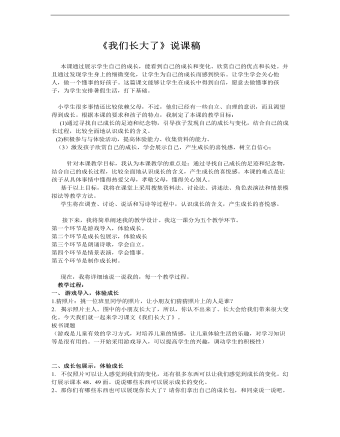
小学科学鄂教版四年级上册《我们长大了》说课稿
小学生很多事情还比较依赖父母,不过,他们已经有一些自立、自理的意识,而且渴望得到成长。根据本课的要求和孩子的特点,我制定了本课的教学目标: (1)通过寻找自己成长的足迹和纪念物,引导孩子发现自己的成长与变化,结合自己的成长过程,比较全面地认识成长的含义。 (2)积极参与与体验活动,提高体验能力、收集资料的能力。 (3)激发孩子欣赏自己的成长,学会展示自己,产生成长的喜悦感,树立自信心; 针对本课教学目标,我认为本课教学的重点是:通过寻找自己成长的足迹和纪念物,结合自己的成长过程,比较全面地认识成长的含义,产生成长的喜悦感。本课的难点是让孩子从具体事情中懂得热爱父母,孝敬父母,懂得关心别人。 基于以上目标,我将在课堂上采用搜集资料法、讨论法、讲述法、角色表演法和情景模拟法等教学方法。
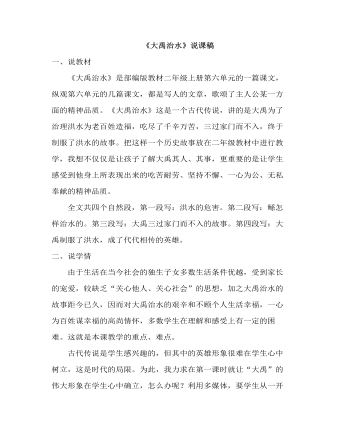
部编人教版二年级上册《大禹治水》说课稿
一、说教材《大禹治水》是部编版教材二年级上册第六单元的一篇课文,纵观第六单元的几篇课文,都是写人的文章,歌颂了主人公某一方面的精神品质。《大禹治水》这是一个古代传说,讲的是大禹为了治理洪水为老百姓造福,吃尽了千辛万苦,三过家门而不入,终于制服了洪水的故事。把这样一个历史故事放在二年级教材中进行教学,我想不仅仅是让孩子了解大禹其人、其事,更重要的是让学生感受到他身上所表现出来的吃苦耐劳、坚持不懈、一心为公、无私奉献的精神品质。全文共四个自然段,第一段写:洪水的危害。第二段写:鲧怎样治水的。第三段写:大禹三过家门而不入的故事。第四段写:大禹制服了洪水,成了代代相传的英雄。
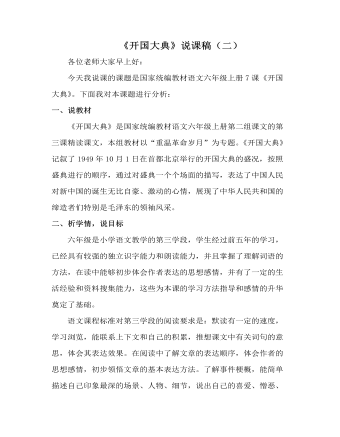
部编人教版六年级上册《开国大典》说课稿(二)
一、说教材《开国大典》是国家统编教材语文六年级上册第二组课文的第三课精读课文,本组教材以“重温革命岁月”为专题。《开国大典》记叙了1949年10月1日在首都北京举行的开国大典的盛况,按照盛典进行的顺序,通过对盛典一个个场面的描写,表达了中国人民对新中国的诞生无比自豪、激动的心情,展现了中华人民共和国的缔造者们特别是毛泽东的领袖风采。二、析学情,说目标六年级是小学语文教学的第三学段,学生经过前五年的学习,已经具有较强的独立识字能力和朗读能力,并且掌握了理解词语的方法,在读中能够初步体会作者表达的思想感情,并有了一定的生活经验和资料搜集能力,这些为本课的学习方法指导和感情的升华奠定了基础。
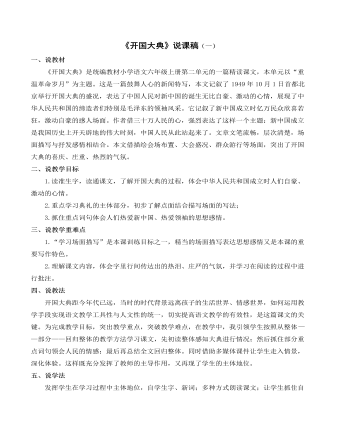
部编人教版六年级上册《开国大典》说课稿(一)
四、说教法 开国大典距今年代已远,当时的时代背景远离孩子的生活世界、情感世界,如何运用教学手段实现语文教学工具性与人文性的统一,切实提高语文教学的有效性,是这篇课文的关键。为完成教学目标,突出教学重点,突破教学难点,在教学中,我引领学生按照从整体——部分——回归整体的教学方法学习课文,先初读整体感知大典进行情况;然后抓住部分重点词句领会人民的情感;最后再总结全文回归整体。同时借助多媒体课件让学生走入情景,深化体验。这样既充分发挥了教师的主导作用,又再现了学生的主体地位。 五、说学法 发挥学生在学习过程中主体地位,自学生字、新词;多种方式朗读课文;让学生抓住自己感兴趣的场景,朗读,想象,谈体会,即通过谈——读——想——体这四个环节,来学习课文,这样既培养了学生的自学能力,又充分发挥了学生的想象力,让学生有效地展开了与文本的对话。
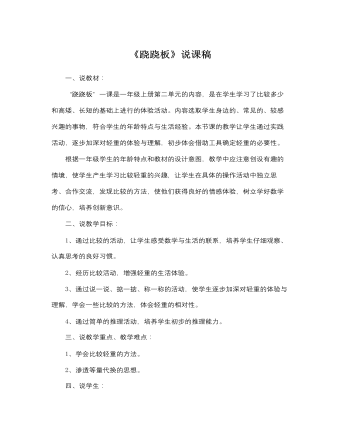
北师大版小学数学一年级上册《跷跷板》说课稿
一、说教材:“跷跷板”一课是一年级上册第二单元的内容,是在学生学习了比较多少和高矮、长短的基础上进行的体验活动。内容选取学生身边的、常见的、较感兴趣的事物,符合学生的年龄特点与生活经验。本节课的教学让学生通过实践活动,逐步加深对轻重的体验与理解,初步体会借助工具确定轻重的必要性。根据一年级学生的年龄特点和教材的设计意图,教学中应注意创设有趣的情境,使学生产生学习比较轻重的兴趣,让学生在具体的操作活动中独立思考、合作交流,发现比较的方法,使他们获得良好的情感体验,树立学好数学的信心,培养创新意识。二、说教学目标:1、通过比较的活动,让学生感受数学与生活的联系,培养学生仔细观察、认真思考的良好习惯。2、经历比较活动,增强轻重的生活体验。3、通过说一说、掂一掂、称一称的活动,使学生逐步加深对轻重的体验与理解,学会一些比较的方法,体会轻重的相对性。4、通过简单的推理活动,培养学生初步的推理能力。
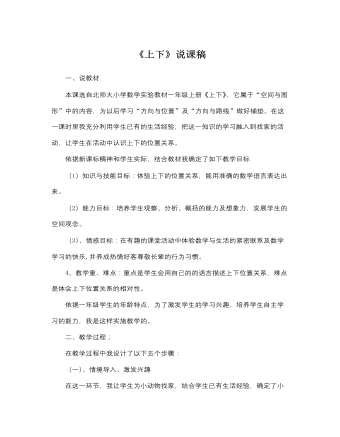
北师大版小学数学一年级上册《上下》说课稿
一、说教材本课选自北师大小学数学实验教材一年级上册《上下》,它属于“空间与图形”中的内容,为以后学习“方向与位置”及“方向与路线”做好铺垫。在这一课时里我充分利用学生已有的生活经验,把这一知识的学习融入到找家的活动,让学生在活动中认识上下的位置关系。依据新课标精神和学生实际,结合教材我确定了如下教学目标(1)知识与技能目标:体验上下的位置关系,能用准确的数学语言表达出来。(2)能力目标:培养学生观察、分析、概括的能力及想象力,发展学生的空间观念。(3)、情感目标:在有趣的课堂活动中体验数学与生活的紧密联系及数学学习的快乐,并养成热情好客尊敬长辈的行为习惯。4、教学重、难点:重点是学生会用自己的的语言描述上下位置关系,难点是体会上下位置关系的相对性。依据一年级学生的年龄特点,为了激发学生的学习兴趣,培养学生自主学习的能力,我是这样实施教学的。

北师大版小学数学一年级上册《文具》说课稿
一、学生分析刚进校的一年级小朋友绝大多数接受了良好的学前教育,10以内数甚至更大的数对小朋友来说并不陌生,但他们对数的实际意义的理解还不是很清晰。除此之外,部分学生在学前还不同程度地学会了1~10各数的书写方法,具备了较好的知识经验,为新课的教学提供了良好的基础。二、教材分析“文具”一课是第一单元“生活中的数”的第五课时。如何从生活中抽象出数的概念,本节课起着重要的作用。教材借助与学生学习息息相关的文具用品这一情境,通过找朋友的活动,使学生能正确数出数量是6~10的物体的个数,初步体会到数都是从实际中抽象、概括出来的,体会到数与实物的对应思想。在此基础上,教材再通过数一数自己铅笔盒里的文具、写一写、说一说、画一画、填一填等数学活动,使学生掌握6~10各数的书写方法,逐步让学生体验实物、符号、数字之间的联系,掌握数数的方法,建立数感。
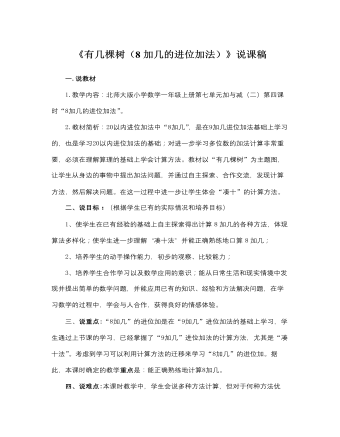
北师大版小学数学一年级上册《有几棵树》说课稿
二、说目标:(根据学生已有的实际情况和培养目标)1、使学生在已有经验的基础上自主探索得出计算8加几的各种方法,体现算法多样化;使学生进一步理解“凑十法”并能正确熟练地口算8加几;2、培养学生的动手操作能力,初步的观察、比较能力;3、培养学生合作学习以及数学应用的意识;能从日常生活和现实情境中发现并提出简单的数学问题,并能应用已有的知识、经验和方法解决问题,在学习数学的过程中,学会与人合作,获得良好的情感体验。三、说重点:“8加几”的进位加是在“9加几”进位加法的基础上学习,学生通过上节课的学习,已经掌握了“9加几”进位加法的计算方法,尤其是“凑十法”。考虑到学习可以利用计算方法的迁移来学习“8加几”的进位加。据此,本课时确定的教学重点是:能正确熟练地计算8加几。四、说难点:本课时教学中,学生会说多种方法计算,但对于何种方法优化,更适合自己有一定的难度。因此,本课的教学难点为:对“凑十法”的进一步理解;体会算法的多样化。

北师大版小学数学一年级下册《采松果》说课稿
一、说教材分析《采松果》一课讲的主要内容是:两位数加、减一位数(不进位、不退位),是在学生熟练掌握20以内加、减法以及整十数加、减整十数的基础上安排的。教材内容分为两部分:一部分是教学两位数加一位数,另一部分是教学两位数减一位数。这两部分内容呈现在同一情境图——“采松果”中,创设了一个充满童趣的生活故事场景,引发学生在读懂图意的基础上,发现其中的数学信息,并能利用这些数学信息提出数学问题。二、说学情分析在学习本节课内容之前,学生已认识了100以内的数,掌握了20以内的加减法以及整十数加、减整十数的计算方法,对于加减法的意义有了一个基本的了解。另外经过上半学期的目标性训练,学生已具有了初步的合作交流意识和提出问题、解决问题的能力,能够有目的地进行探索性学习。但是,对于单纯的口算学习学生的学习兴趣并不是很浓,因此,激发学生的学习兴趣,使学生想学、乐学便显得尤为重要。
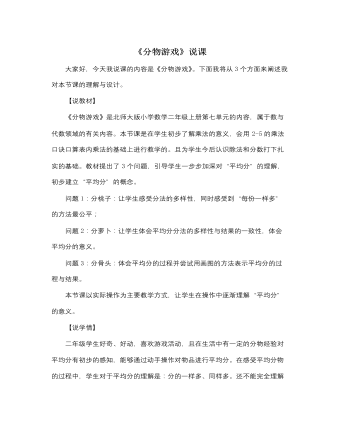
北师大版小学数学二年级上册《分物游戏》说课稿
大家好,今天我说课的内容是《分物游戏》。下面我将从3个方面来阐述我对本节课的理解与设计。【说教材】《分物游戏》是北师大版小学数学二年级上册第七单元的内容,属于数与代数领域的有关内容。本节课是在学生初步了解乘法的意义,会用2-5的乘法口诀口算表内乘法的基础上进行教学的。且为学生今后认识除法和分数打下扎实的基础。教材提出了3个问题,引导学生一步步加深对“平均分”的理解,初步建立“平均分”的概念。问题1:分桃子:让学生感受分法的多样性,同时感受到“每份一样多”的方法最公平;问题2:分萝卜:让学生体会平均分分法的多样性与结果的一致性,体会平均分的意义。问题3:分骨头:体会平均分的过程并尝试用画图的方法表示平均分的过程与结果。本节课以实际操作为主要教学方式,让学生在操作中逐渐理解“平均分”的意义。
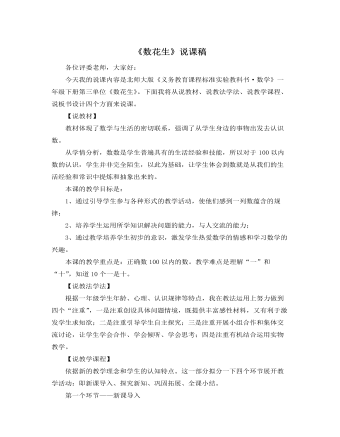
北师大版小学数学一年级下册《数花生》说课稿
各位评委老师,大家好:今天我的说课内容是北师大版《义务教育课程标准实验教科书·数学》一年级下册第三单位《数花生》。下面我将从说教材、说教法学法、说教学课程、说板书设计四个方面来说课。【说教材】教材体现了数学与生活的密切联系,强调了从学生身边的事物出发去认识数。从学情分析,数数是学生普遍具有的生活经验和技能,所以对于100以内数的认识,学生并非完全陌生,以此为基础,让学生体会到数就是从我们的生活经验和常识中提炼和抽象出来的。本课的教学目标是:1、通过引导学生参与各种形式的教学活动,使他们感到一列数蕴含的规律;2、培养学生运用所学知识解决问题的能力,与人交流的能力;3、通过教学培养学生初步的意识,激发学生热爱数学的情感和学习数学的兴趣。
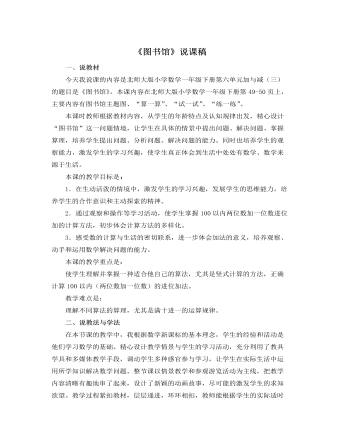
北师大版小学数学一年级下册《图书馆》说课稿
本课时教师根据教材内容,从学生的年龄特点及认知规律出发,精心设计“图书馆”这一问题情境,让学生在具体的情景中提出问题、解决问题、掌握算理,培养学生提出问题、分析问题、解决问题的能力。同时也培养学生的观察能力,激发学生的学习兴趣,使学生真正体会到生活中处处有数学、数学来源于生活。本课的教学目标是:1.在生动活泼的情境中,激发学生的学习兴趣,发展学生的思维能力,培养学生的合作意识和主动探索的精神。2.通过观察和操作等学习活动,使学生掌握100以内两位数加一位数进位加的计算方法,初步体会计算方法的多样化。3.感受数的计算与生活的密切联系,进一步体会加法的意义,培养观察、动手和运用数学解决问题的能力。本课的教学重点是:使学生理解并掌握一种适合他自己的算法,尤其是竖式计算的方法,正确计算100以内(两位数加一位数)的进位加法。教学难点是:理解不同算法的算理,尤其是满十进一的运算规律。
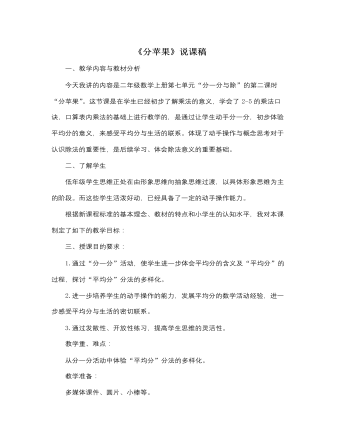
北师大版小学数学二年级上册《分苹果》说课稿
1.故事情境法;2.激励法;3.多媒体辅助法;4.开放式教学法“教是为了不教”,可见教学贵在教给学生学习方法。教学中让学生充分地参与探究,动手实践,讨论交流,获取新知,领悟方法,形成解决问题的能力。五、授课过程为了实现以上教学目标,根据新课程倡导的理念和学生的年龄特征,本节课我以“笑笑过生日”这个故事情境贯穿课的始末,引导学生在“实践”中学习、在“实践”中体验,设计了如下教学流程:1、创设情境、激发兴趣:俗话说:“良好的开端是成功的一半”,而兴趣是学习入门的向导,是激发学生求知欲,吸引学生乐学的内在动力。本节课的导入部分,我创设了这样一个情境,笑笑过生日,请来了许多客人,准备了一袋苹果来招待客人,想让小朋友帮助笑笑来分一分。同学们,现在就请你们用手中的12根小棒代替苹果,动手分一分,看一看这12个苹果你怎么分?这节课,我们就来学习分苹果。(板书:分苹果)

